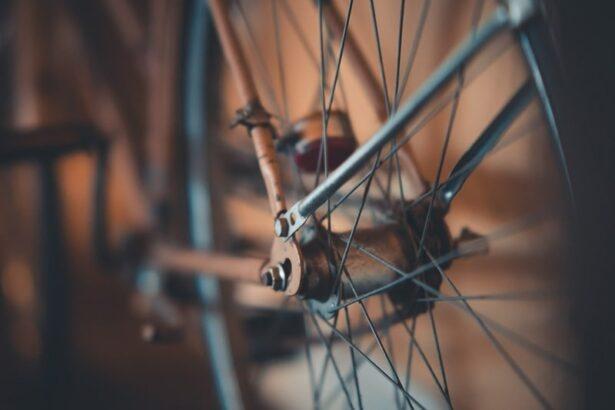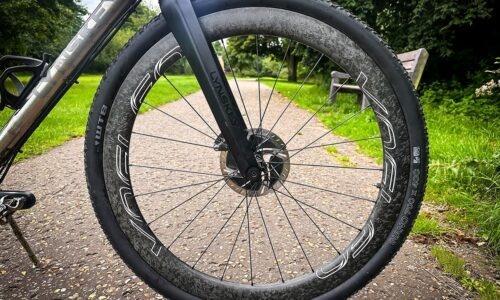I. Introduction
Proper lubrication is crucial for maintaining the performance and longevity of bicycle bearings. These bearings are essential components that enable smooth rotation and minimize friction in various parts of the bike, such as hubs, bottom brackets, headsets, and pedals.
Without adequate lubrication, bearings can wear out rapidly, resulting in increased friction, decreased efficiency, and potential damage to components. By using the appropriate lubricant on bicycle bearings, cyclists can significantly decrease the resistance caused by friction, allowing for smooth and effortless component rotation.
In this article, we will delve into the importance of proper bicycle bearing lubrication and provide an overview of the subject. We will examine the different types of bearings found in bicycles, outline the benefits of correct lubrication, assist you in selecting the ideal lubricant for your specific requirements, offer step-by-step guidance on lubrication techniques, and stress the significance of regular maintenance and inspection.
By comprehending and applying the principles of proper lubrication, you can keep your bike operating at its peak, prolonging its lifespan and enhancing your overall riding experience.
Top 5 Bike Greases for Bearings
1. Park Tool PPL-1 PolyLube 1000 Grease
Park Tool PPL-1 PolyLube 1000 Grease is a high-quality lubricant specifically designed for bike applications.
Pros
- Provides excellent lubrication for smooth bearing operation.
- Reduces friction and minimizes wear on bearings.
- Offers long-lasting protection against corrosion.
- Compatible with a wide range of bearing materials.
Cons
- May not be ideal for extreme temperature conditions.
- Packaging may not be as user-friendly compared to some other options.
This grease is a popular choice among cyclists for its excellent lubricating properties, versatility, and compatibility with various bike components. It is an ideal option for general bike maintenance and lubrication tasks.
2. Finish Line Premium Grease
Finish Line Premium Grease is a high-quality lubricant formulated specifically for bike applications. It provides superior lubrication, reducing friction and ensuring smooth operation of bike bearings.
Pros
- Offers excellent lubrication for optimal bearing performance.
- Reduces friction and minimizes wear on bearings.
- Provides long-lasting protection against corrosion.
- Suitable for all types of bike bearings, including ceramic bearings.
Cons
- May require more frequent reapplication compared to some specialized greases for extreme conditions.
- Slightly higher price point compared to some other options.
Ideal Applications and Compatibility
It is compatible with various bearing materials commonly found in bikes, including steel, aluminum, and ceramic. It is also compatible with other bike components such as cables, threads, and bolts. However, always refer to the manufacturer’s guidelines and specifications for specific compatibility information.
It is well-suited for general bike maintenance and lubrication tasks, ensuring optimal performance and longevity of bike bearings.
3. Phil Wood Waterproof Grease
Phil Wood Waterproof Grease is designed to provide exceptional performance and protection in wet and muddy conditions.
Pros
- Offers excellent lubrication and reduces friction for smooth operation in wet conditions.
- Provides long-lasting protection against corrosion
- High water resistance properties, ensuring optimal performance in rainy and muddy environments.
- Versatile and suitable for various bike components, including bearings, threads, and pedals.
Cons
- Slightly higher price point compared to some other greases.
- Thicker consistency may require more effort during application.
Ideal Applications and Compatibility
Phil Wood Waterproof Grease is ideal for bike applications that require superior water resistance and long-lasting protection.
Phil Wood Waterproof Grease is a popular choice among cyclists who frequently ride in wet and muddy conditions.
4. Shimano Dura-Ace Grease
Shimano Dura-Ace Grease is a high-quality lubricant specifically formulated for bike applications, designed to meet the demands of professional cyclists and avid enthusiasts.
Pros
- Provides high-quality lubrication for optimal bearing performance and smooth operation.
- Reduces friction and minimizes wear, extending the lifespan of bike bearings.
- Offers excellent protection against corrosion, even in demanding riding conditions.
- Specifically formulated for Shimano bicycle components, ensuring compatibility and optimal performance.
Cons
- May have a slightly higher price point compared to some other greases.
- Limited availability for non-Shimano component applications.
Ideal Applications and Compatibility
Shimano Dura-Ace Grease is specifically designed for Shimano bicycle components. It is recommended to refer to the manufacturer’s guidelines for compatibility with non-Shimano components.
Shimano Dura-Ace Grease is highly regarded among professional cyclists and bike enthusiasts who prioritize optimal performance and compatibility with Shimano components.
5. Rock-N-Roll Super-Web Grease
Rock-N-Roll Super-Web Grease is formulated to provide excellent lubrication and protection in various riding conditions.
Pros
- Offers high-performance lubrication for smooth and efficient bearing operation.
- Provides long-lasting protection against corrosion and rust.
- Versatile and suitable for various bike components
- Easy and precise application.
Cons
- May require more frequent reapplication in extreme riding conditions.
- Availability may vary depending on the region.
Ideal Applications and Compatibility
Rock-N-Roll Super-Web Grease is compatible with various bearing materials commonly found in bikes, including steel, aluminum, and titanium. It is also compatible with most other bike components.
Rock-N-Roll Super-Web Grease is a popular choice among cyclists seeking high-performance lubrication and protection.
III. Understanding Bike Bearings Function

Bike bearings are vital for the seamless operation and performance of bicycles. As mechanical components, they enable rotational movement and minimize friction between different parts of the bike. Grasping the function and types of bike bearings is critical for maintaining and optimizing their performance.
The function of bike bearings involves providing support and facilitating smooth rotation in various areas of the bicycle. They act as a connection between moving parts, allowing them to rotate with minimal friction.
The primary function of bike bearings includes:
- Ensuring Crankset Rotation
- Enabling Steering Control
- Assisting Pedal Rotation
Types of Bike Bearings
There are different types of bearings used in bicycles, each with its own design and characteristics. The two main types commonly found in bikes are:
Cartridge Bearings: These bearings are pre-assembled units housed in a cartridge or sealed unit. They are easy to install and replace, and the sealed design provides protection against dirt, moisture, and contaminants.
Loose Ball Bearings: These bearings consist of individual loose balls housed in a race or bearing cup. They require more maintenance and adjustment but offer greater customization options and are commonly found in older or high-performance bikes.
In the subsequent sections of this article, we will delve deeper into the significance of lubrication, examining techniques for selecting the ideal lubricant and maintaining bike bearings for optimal performance.
IV. Types of Grease and their Properties
 Grease serves as a vital lubricant in numerous mechanical applications, including bike bearings. It is composed of three main components: base oil, thickener, and additives.
Grease serves as a vital lubricant in numerous mechanical applications, including bike bearings. It is composed of three main components: base oil, thickener, and additives.
Each component contributes to the grease’s overall properties and performance. Understanding the composition, key properties, and common types of grease is crucial for selecting the right lubricant to ensure optimal performance and longevity of bike bearings.
The upcoming paragraphs will delve into the intricate components of grease, dissect its essential characteristics such as its thickness, texture, tolerance to different temperatures, and resistance to water. Additionally, we shall offer a comprehensive overview of the most prevalent forms of grease available on the market.
Let’s explore these components in more detail:
Base Oil
The base oil is the primary lubricating component of grease. It can be mineral oil, synthetic oil, or a blend of both. The choice of base oil depends on factors such as temperature range, load capacity, and desired performance characteristics.
Thickener
The thickener gives grease its structure and consistency. It acts as a sponge, holding the base oil in a semi-solid or solid state. The most commonly used thickeners in grease formulations are metallic soaps, such as lithium, calcium, or aluminum complex.
Additives
Additives are incorporated into grease formulations to enhance specific properties and provide additional benefits. Some common additives found in grease include: Anti-wear Agents, Antioxidants, Corrosion Inhibitors, Water Resistance Additives.
The combination of base oil, thickener, and additives in grease formulations is carefully engineered to meet specific application requirements, such as temperature range, load capacity, and environmental conditions. The key properties of grease include viscosity, consistency, temperature range, and water resistance.
Viscosity
Viscosity refers to a grease’s resistance to flow. It determines how easily the grease spreads and adheres to surfaces. Proper viscosity selection depends on factors such as temperature, speed, and load requirements.
Consistency
Consistency refers to the firmness or softness of the grease. Consistency affects the grease’s ability to stay in place, resist leakage, and provide effective lubrication under various operating conditions.
Temperature Range
The temperature range indicates the minimum and maximum temperatures at which a grease can perform optimally. Greases have specific temperature limits, and operating outside these limits can result in inadequate lubrication, reduced performance, or even grease failure. It is crucial to select a grease that can withstand the anticipated temperature extremes of the application.
Water Resistance
Water resistance is an important property, especially in applications where the grease may come into contact with moisture or water. Greases with good water resistance prevent water intrusion, maintain their lubricating properties, and protect surfaces from corrosion and rust.
Common Types of Grease
Lithium Grease: Lithium-based greases are versatile and widely used in various applications. They offer good temperature stability, water resistance, and mechanical stability.
Calcium Grease: Calcium-based greases provide excellent water resistance and are commonly used in marine applications or environments with high humidity.
Polyurea Grease: Polyurea-based greases have high-temperature stability, mechanical stability, and good shear resistance. They are suitable for high-speed applications.
Synthetic Grease: Synthetic greases are formulated with synthetic base oils, offering superior performance in terms of temperature range, oxidation resistance, and load-carrying capacity.
V. Factors to Consider When Choosing Bike Grease for Bearings Bike Usage

When choosing bike grease for bearings, there are several factors to consider to ensure optimal performance and longevity.
These factors include: bike usage, bearing type, climate and riding conditions, as well as maintenance frequency and skill level.
By considering these factors, you can choose a bike grease that aligns with your specific needs and ensures optimal performance and protection for your bike bearings.
VI. How to Apply Grease to Bike Bearings
Applying grease to bike bearings is a relatively straightforward process. Here’s a brief guide on how to do it:
- Clean the bearings. Start by cleaning and remove any old grease and dirt to ensure a clean surface for the new grease.
- Take a small amount of grease on your fingers or a clean tool and apply it evenly to the bearing surfaces.
- Once the grease is applied, carefully reassemble the bearings back into their respective components.
- After reassembly, wipe off any excess grease to prevent it from attracting dirt and debris.
VII. Frequently Asked Questions
1. Can I use multi-purpose grease for bike bearings?
It is generally recommended to use grease specifically formulated for bike applications. Multi-purpose greases may not have the necessary properties to provide optimal lubrication and protection for bike bearings.
2. How often should I re-grease my bike bearings?
The frequency of re-greasing bike bearings depends on various factors, including usage, riding conditions, and maintenance practices. It is recommended to re-grease bike bearings annually or after approximately 2,000-3,000 miles of riding.
However, if you frequently ride in wet or dusty conditions, it may be necessary to re-grease more frequently to ensure optimal performance and protection.
3. Can I mix different types of grease?
It is not recommended to mix different types of grease. Different greases may have different formulations, additives, and compatibility characteristics. To ensure optimal performance and compatibility, it is best to stick to a single type of grease.
Final Words
Choosing the appropriate grease and maintaining proper lubrication is essential for ensuring the optimal performance and longevity of bike bearings. By carefully evaluating factors such as performance, compatibility, ease of application, and specific riding conditions, you can select a grease that best meets your requirements.
Keep in mind that bike bearings are subject to various riding conditions, including temperature fluctuations, exposure to moisture, and high mechanical stress. By investing in high-quality bike grease and maintaining your bike’s bearings, you can optimize the performance, reliability, and lifespan of your bike’s bearings.
Therefore, prioritize selecting the right grease and remain consistent with regular maintenance. By doing so, you can enjoy smoother rides, enhanced efficiency, and peace of mind knowing that your bike is well-protected and prepared for any adventure that awaits.

Anita, an avid cyclist with over a decade of experience, began her journey on two wheels as a means to stay fit and explore her local surroundings. Her passion for the sport quickly grew, transforming her into a devoted and competitive rider.
With a penchant for both on and off-road cycling, Anita constantly seeks out new trails and routes to conquer. Her competitive spirit has led her to participate in numerous races and events, securing a spot on the podium in most of them.




